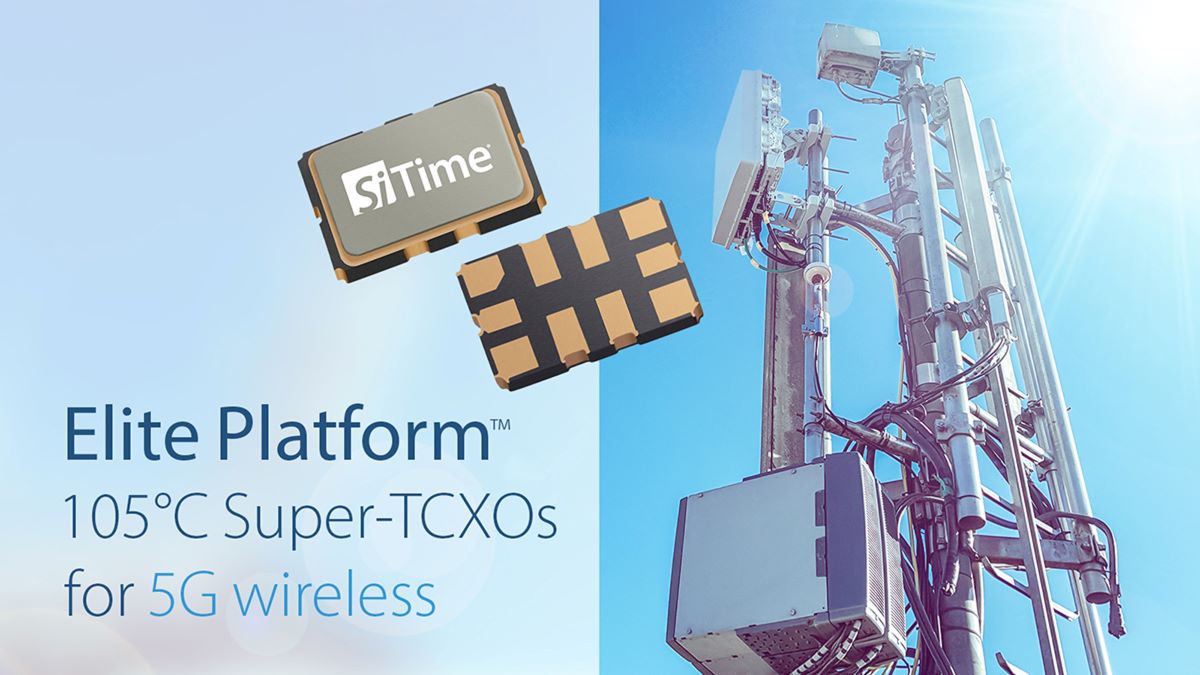
SiTime is in volume production with its Elite Platform™ of temperature-compensated crystal oscillators (TCXO), which provide high stability and dynamic performance to 105°C operating temperatures.
Designed for IEEE 1588-based synchronization in 5G and LTE-Advanced mobile networks, the Elite Platform supports smaller, more densely integrated radios for mounting on lamp posts, traffic lights, telephone poles and the sides of buildings, where the radio has limited heat sinking and will run hotter. Without higher temperature components, radio performance can degrade, including a loss of synchronization. Synchronization enables networks to maintain service quality and operating reliability, and the use of eCPRI and distributed architectures in the latest generation of 4G and 5G networks increases the timing complexity for synchronization.
SiTime’s SiT5356 and SiT5357 Elite Platform MEMS Super-TCXOs are available with an extended -40°C to +105°C operating temperature range, ensuring better dynamic performance and timing stability in the presence of harsh environments due to limited air flow, temperature changes, mechanical shock, vibration, power supply noise and electromagnetic interference.
HIGHER TEMPERATURE OPERATIONTCXOs are designed to provide a stable frequency despite temperature changes, yet TCXOs are difficult to find with an operating temperature above +85°C, which has long been considered the upper range for industrial applications. However, the tight packaging requirements for small cells cause the internal temperatures in system enclosures to exceed industrial norms. Even systems using active cooling — brushless DC fans, for example — to keep temperatures within the specified operating range may have failures. With a lower MTBF compared to the electronic components, cooling fans can malfunction. Because of this risk, using components with a greater maximum temperature range provides margin in case of a cooling system failure.
SiTime has evaluated the performance of various quartz oscillators, measuring the stability beyond the rated +85°C operating temperature range, testing performance to +125°C (see Figure 1).

The figure plots the performance degradation at these higher temperatures compared to the performance of the SiTime SiT5356 Super-TCXO, which is rated for -40°C to +125°C operation. To make the comparison easier, the value of each device is normalized to its output frequency at +85°C. The MEMS-based Super-TCXO demonstrates little degradation, while the quartz TCXOs degrade more than 28,000 ppb.
Because the quartz oscillator frequency offset is extreme, it is difficult to assess the actual performance of the SiT5356 in Figure 1. Figure 2 shows a zoomed-in view of the +85°C to +125°C region, showing the offset is approximately -50 ppb at +125°C.

While frequency stability is a critical performance specification for precision oscillators, another important metric is the slope of frequency versus temperature (Δf/ΔT). In systems requiring time and frequency transfer using IEEE 1588, better Δf/ΔT improves the time error. Figure 3 shows the slope (Δf/ΔT) from +85°C to +125°C for the same five industrial-rated TCXOs compared to the SiT5356 Super-TCXO. Again, the curves are normalized to the frequency slope at +85°C.

The frequency slope of the quartz-based devices rapidly degrades just outside the rated temperature, increasing from 10 ppb/°C between +85°C and +95°C to almost 3000 ppb/°C at +125°C. The MEMS-based SiT5356 has a frequency slope that is better than 2 ppb/°C up to +105°C, increasing to just 8 ppb/°C at +125°C.
SYSTEM IMPACTTCXOs are used in applications where a high stability frequency reference is required, such as cellular remote radio heads. With communities and operators demanding smaller radios, the equipment must operate in increasingly hot environments. To do so requires a timing solution that withstands the high temperatures and maintains system functionality. The extended temperature operation of SiTime’s Super-TCXOs helps ensure these systems will continue to function in stressful environments, minimizing down time to maintain revenue-generating data traffic for the operators. With oscillators that “stay cool” in high heat, SiTime’s timing technology provides the robustness needed for advanced 4G and 5G networks.
ADDITIONAL INFORMATIONSiTime’s application note AN10063 TCXO and OCXO Stability Degradation provides information about the stability performance of TCXOs and OCXOs, including more measured data than presented in this article, including larger samples with device-to-device variation data.
Watch the dynamic performance of a ±100 ppb Elite Super-TCXO versus a ±50 ppb quartz TCXO under airflow, temperature ramp, tap test and VDD fluctuation:
SiTime Corporation
Santa Clara, Calif.
www.sitime.com
